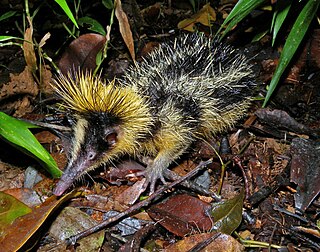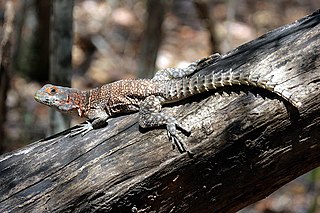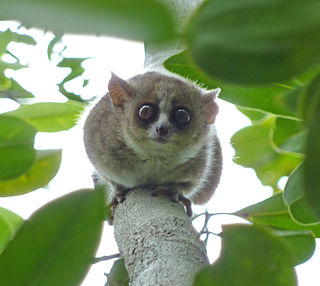
Primates are a diverse order of mammals. They are divided into the strepsirrhines, which include the lemurs, galagos, and lorisids, and the haplorhines, which include the tarsiers and the simians. Primates arose 85–55 million years ago first from small terrestrial mammals, which adapted to living in the trees of tropical forests: many primate characteristics represent adaptations to life in this challenging environment, including large brains, visual acuity, color vision, a shoulder girdle allowing a large degree of movement in the shoulder joint, and dextrous hands. Primates range in size from Madame Berthe's mouse lemur, which weighs 30 g (1 oz), to the eastern gorilla, weighing over 200 kg (440 lb). There are 376–524 species of living primates, depending on which classification is used. New primate species continue to be discovered: over 25 species were described in the 2000s, 36 in the 2010s, and three in the 2020s.

Placental mammals are one of the three extant subdivisions of the class Mammalia, the other two being Monotremata and Marsupialia. Placentalia contains the vast majority of extant mammals, which are partly distinguished from monotremes and marsupials in that the fetus is carried in the uterus of its mother to a relatively late stage of development. The name is something of a misnomer considering that marsupials also nourish their fetuses via a placenta, though for a relatively briefer period, giving birth to less developed young which are then nurtured for a period inside the mother's pouch.

Tenrecomorpha is the suborder of otter shrews and tenrecs, a group of afrotherian mammals indigenous to equatorial Africa and Madagascar, respectively. The two families are thought to have split about 47–53 million years ago. Potamogalid otter shrews were formerly considered a subfamily of Tenrecidae. The suborder is also presumed to contain the extinct genus Plesiorycteropus, a group of possibly fossorial insectivores similar to aardvarks, which is known to be more closely related to tenrecs of subfamily Tenrecinae than to golden moles of suborder Chrysochloridea.

A tenrec is any species of mammal within the afrotherian family Tenrecidae, which is endemic to Madagascar. Tenrecs are a very diverse group; as a result of convergent evolution some resemble hedgehogs, shrews, opossums, rats, and mice. They occupy aquatic, arboreal, terrestrial, and fossorial environments. Some of these species including the greater hedgehog tenrec, can be found in the Madagascar dry deciduous forests. However, the speciation rate in this group has been higher in humid forests.

The Opluridae, or Madagascan iguanas, are a family of moderately sized lizards native to Madagascar and Grande Comore. There are eight species in two genera, with most of the species being in Oplurus. The Opluridae, along with Brachylophus of Fiji, are the only extant members of the Pleurodonta that are found outside the Americas.

Leiosauridae is a family of iguanian lizards containing six genera and 34 species. The family is endemic to Central America and South America.

The Iguanidae is a family of lizards composed of the iguanas, chuckwallas, and their prehistoric relatives, including the widespread green iguana.

New World monkeys are the five families of primates that are found in the tropical regions of Mexico, Central and South America: Callitrichidae, Cebidae, Aotidae, Pitheciidae, and Atelidae. The five families are ranked together as the Ceboidea, the only extant superfamily in the parvorder Platyrrhini.

The Great American Biotic Interchange, also known as the Great American Interchange and the Great American Faunal Interchange, was an important late Cenozoic paleozoogeographic biotic interchange event in which land and freshwater fauna migrated from North America via Central America to South America and vice versa, as the volcanic Isthmus of Panama rose up from the sea floor and bridged the formerly separated continents. Although earlier dispersals had occurred, probably over water, the migration accelerated dramatically about 2.7 million years (Ma) ago during the Piacenzian age. It resulted in the joining of the Neotropic and Nearctic biogeographic realms definitively to form the Americas. The interchange is visible from observation of both biostratigraphy and nature (neontology). Its most dramatic effect is on the zoogeography of mammals, but it also gave an opportunity for reptiles, amphibians, arthropods, weak-flying or flightless birds, and even freshwater fish to migrate. Coastal and marine biota, however, was affected in the opposite manner; the formation of the Central American Isthmus caused what has been termed the Great American Schism, with significant diversification and extinction occurring as a result of the isolation of the Caribbean from the Pacific.

Caviomorpha is the rodent infraorder or parvorder that unites all New World hystricognaths. It is supported by both fossil and molecular evidence. The Caviomorpha was for a time considered to be a separate order outside the Rodentia, but is now accepted as a genuine part of the rodents. Caviomorphs include the extinct Heptaxodontidae, the extinct Josephoartigasia monesi and extant families of chinchilla rats, hutias, guinea pigs and the capybara, chinchillas and viscachas, tuco-tucos, agoutis, pacas, pacaranas, spiny rats, New World porcupines, coypu and octodonts.
In phylogenetics, basal is the direction of the base of a rooted phylogenetic tree or cladogram. The term may be more strictly applied only to nodes adjacent to the root, or more loosely applied to nodes regarded as being close to the root. Note that extant taxa that lie on branches connecting directly to the root are not more closely related to the root than any other extant taxa.

Early human migrations are the earliest migrations and expansions of archaic and modern humans across continents. They are believed to have begun approximately 2 million years ago with the early expansions out of Africa by Homo erectus. This initial migration was followed by other archaic humans including H. heidelbergensis, which lived around 500,000 years ago and was the likely ancestor of Denisovans and Neanderthals as well as modern humans. Early hominids had likely crossed land bridges that have now sunk.

The Tristan hotspot is a volcanic hotspot which is responsible for the volcanic activity which forms the volcanoes in the southern Atlantic Ocean. It is thought to have formed the island of Tristan da Cunha and the Walvis Ridge on the African Plate.

In paleoanthropology, the recent African origin of modern humans or the "Out of Africa" theory (OOA) is the most widely accepted model of the geographic origin and early migration of anatomically modern humans. It follows the early expansions of hominins out of Africa, accomplished by Homo erectus and then Homo neanderthalensis.

Lemurs, primates belonging to the suborder Strepsirrhini which branched off from other primates less than 63 million years ago, evolved on the island of Madagascar, for at least 40 million years. They share some traits with the most basal primates, and thus are often confused as being ancestral to modern monkeys, apes, and humans. Instead, they merely resemble ancestral primates.

Brachylophus gibbonsi is an extinct species of large iguanid lizard from Tonga in the South Pacific Ocean. Its remains have been found associated with cultural sites on Lifuka, four other islands in the Haʻapai group, and Tongatapu. It was consumed by the early Tongans and probably became extinct within a century of human colonization of the archipelago 2800 years ago.

Several expansions of populations of archaic humans out of Africa and throughout Eurasia took place in the course of the Lower Paleolithic, and into the beginning Middle Paleolithic, between about 2.1 million and 0.2 million years ago (Ma). These expansions are collectively known as Out of Africa I, in contrast to the expansion of Homo sapiens (anatomically modern humans) into Eurasia, which may have begun shortly after 0.2 million years ago.

Megalocnidae is an extinct family of sloths, native to the islands of the Greater Antilles from the Early Oligocene to the Mid-Holocene. They are known from Cuba, Hispaniola and Puerto Rico, but are absent from Jamaica. While they were formerly placed in the Megalonychidae alongside two-toed sloths and ground sloths like Megalonyx, recent mitochondrial DNA and collagen sequencing studies place them as the earliest diverging group basal to all other sloths. They displayed significant diversity in body size and lifestyle, with Megalocnus being terrestrial and probably weighing several hundred kilograms, while Neocnus was likely arboreal and similar in weight to extant tree sloths, at less than 10 kilograms.
















